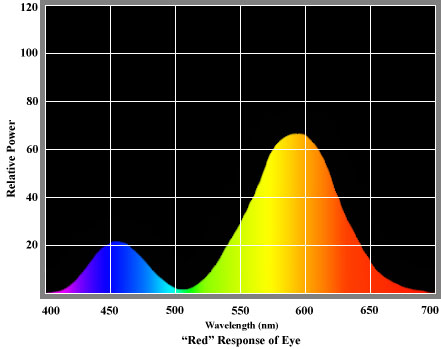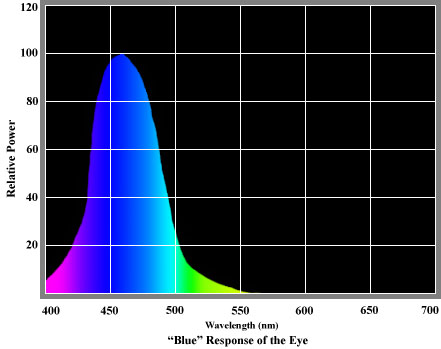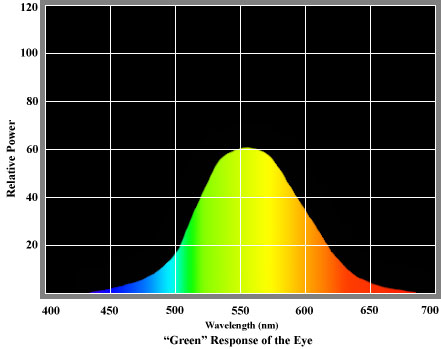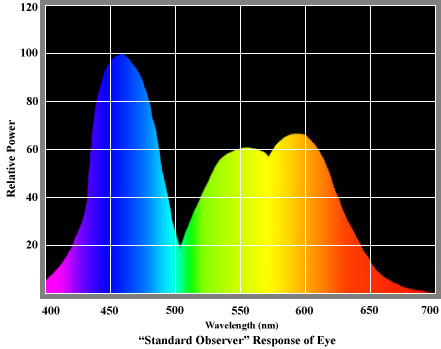 Colour seems simple - at least until one begins to think about it! Every day our eyes settle upon objects that we describe as red, blue, green or any of the other commonly known hues. Everyone knows that grass is green, so it may surprise many to learn that it is not. Colour does not really exist as a physical property of objects. It is created only within our own heads as a consequence of the combined functions of our eyes and brain. Had human beings evolved in a slightly different manner, grass might have appeared to all of us as a particular shade of yellow or blue.
Colour seems simple - at least until one begins to think about it! Every day our eyes settle upon objects that we describe as red, blue, green or any of the other commonly known hues. Everyone knows that grass is green, so it may surprise many to learn that it is not. Colour does not really exist as a physical property of objects. It is created only within our own heads as a consequence of the combined functions of our eyes and brain. Had human beings evolved in a slightly different manner, grass might have appeared to all of us as a particular shade of yellow or blue.
In the real physical world there is no colour as such. The Earth is nevertheless bathed in electromagnetic radiation of countless different wavelengths, and a small range of these wavelengths is detected by the human eye. However it is important to realize that we remain totally blind to most of the radiation striking the planet. The small part of the electromagnetic spectrum that we are equipped to "see" is known, not surprisingly, as the visible spectrum. Our eyes respond to the range of wavelengths in this region and, in combination with sophisticated processing undertaken by the brain, allow us to perceive the colours of the rainbow.
 The accurate measurement of colour, as perceived by human beings, is consequently dependent upon defining and modelling the response of the human eye and brain to the wavelengths of the visible spectrum. Only when the behaviour of the eye and brain combination is understood is it possible to design an artificial system capable of measuring colour in a meaningful manner.
The accurate measurement of colour, as perceived by human beings, is consequently dependent upon defining and modelling the response of the human eye and brain to the wavelengths of the visible spectrum. Only when the behaviour of the eye and brain combination is understood is it possible to design an artificial system capable of measuring colour in a meaningful manner.
Inevitably, the eyes of human beings respond to the radiation within the visible spectrum in slightly different ways. Some individual observers are able to see better in the dark than others, and some may be able to see a little more or less at the red or blue ends of the spectrum. Indeed, do we all see precisely the same shade of green when viewing a particular area of grass? Probably not, although the perceived differences are likely to be very small. So it is possible, at least in broad terms, to characterize the response of an average human eye to radiation within the visible spectrum. This characterization is said to represent a "standard observer".
Several significant problems arise when trying to match the performance of instrumentation to that of an average human eye. These are that:
- the eye and brain combination is extremely sophisticated and adaptable, and may even adjust what is perceived to match what an observer expects;
- the iris of the eye allows it to adapt to a huge range of brightness; and
- the response of the eye to the wavelengths of the visible spectrum is far from linear.
 The eye has three different responses to the wavelengths of the visible spectrum, and the phenomenon we know as colour is produced by a combination of all three. The three responses are known, largely for convenience, and the red, green and blue responses. The diagram at top right shows the most complex of these three elemental responses, and is often known as the red response because it provides much of our ability to see the red end of the spectrum (the longer wavelengths). The characteristic has two obvious peaks in quite different parts of the visible spectrum, and is therefore the most difficult of the three responses to model within measurement instrumentation.
The eye has three different responses to the wavelengths of the visible spectrum, and the phenomenon we know as colour is produced by a combination of all three. The three responses are known, largely for convenience, and the red, green and blue responses. The diagram at top right shows the most complex of these three elemental responses, and is often known as the red response because it provides much of our ability to see the red end of the spectrum (the longer wavelengths). The characteristic has two obvious peaks in quite different parts of the visible spectrum, and is therefore the most difficult of the three responses to model within measurement instrumentation.
The second diagram shows the so-called blue response of the eye. This is the response that provides most of the eye's sensitivity to the blue end or the spectrum where the shorter wavelengths are found. The shape of the characteristic is somewhat simpler to model than in the case of the red response, and incorporates only a singe well-defined peak.
The third characteristic, sometimes known as the green response, broadly provides sensitivity to the green and yellow areas of the visible spectrum. It also has only a single peak which occurs at a wavelength of about 550 nanometres. This response represents, in several ways, the principal response of the eye to the visible spectrum. It is the broadest of the three responses in terms of the wavelengths it spans, and the large peak represents maximum sensitivity to the yellow and green wavelengths. As discussed in other articles, this is the area of maximum sensitivity for the eye and the basic reason why yellow sodium street lights are so effective.
 All this may be very interesting but, to understand the overall response of the eye to the complete visible spectrum, the three individual responses must be combined. This has been done in the fourth diagram at the bottom of the page, and for illustrative purposes only, by simply overlaying the three single-response characteristics. It can be seen that the the four peaks have merged in to three because the two responses at the blue end of the spectrum have been combined in to a single peak. This combined characteristic, which now represents what is known as a standard observer, has great significance in colorimetry.
All this may be very interesting but, to understand the overall response of the eye to the complete visible spectrum, the three individual responses must be combined. This has been done in the fourth diagram at the bottom of the page, and for illustrative purposes only, by simply overlaying the three single-response characteristics. It can be seen that the the four peaks have merged in to three because the two responses at the blue end of the spectrum have been combined in to a single peak. This combined characteristic, which now represents what is known as a standard observer, has great significance in colorimetry.
Any instrumentation designed to measure colour must be matched as closely as possible to this standard observer characteristic. The instrument will then "see" the wavelengths of the visible spectrum in a manner very similar to that of the human eye and brain. However, in practical terms, this is not too easy to achieve.
 A simple answer would seem to be to create an instrument incorporating three filtered photodetectors, each tuned to one of the three basic (red, green or blue) responses of the human eye. This is known as a tri-stimulus colorimeter. Such a device may prove adequate under certain conditions, but its combined characteristic would be unlikely to have more than a passing resemblance to that of the human eye. Another approach would be to create an instrument incorporating four photodetectors to model more closely the four peaks of response found within the three elemental human-eye characteristics. A problem with both approaches is that the complexity of the required band-pass filtering is such that not much light is transmitted. This limits the practical use of such instruments.
A simple answer would seem to be to create an instrument incorporating three filtered photodetectors, each tuned to one of the three basic (red, green or blue) responses of the human eye. This is known as a tri-stimulus colorimeter. Such a device may prove adequate under certain conditions, but its combined characteristic would be unlikely to have more than a passing resemblance to that of the human eye. Another approach would be to create an instrument incorporating four photodetectors to model more closely the four peaks of response found within the three elemental human-eye characteristics. A problem with both approaches is that the complexity of the required band-pass filtering is such that not much light is transmitted. This limits the practical use of such instruments.
A better but somewhat more complex and expensive approach is to use a sampling technique. Discrete samples of spectral radiance are taken at a range of points across the visible spectrum, and the data is used to calculate the colour seen by the eye. Such a device is known as a spectro-radiometer. Instruments of this type produce accurate results under most conditions provided the sampling rate and consequent resolution are sufficient to capture all the data within the standard observer characteristic.






